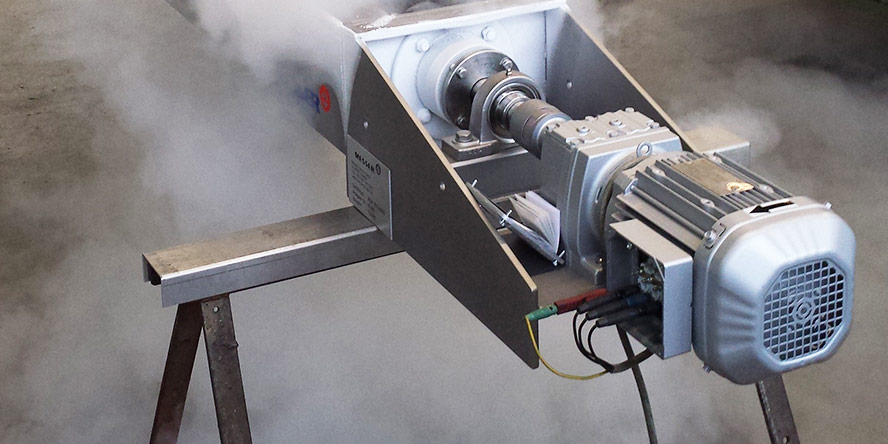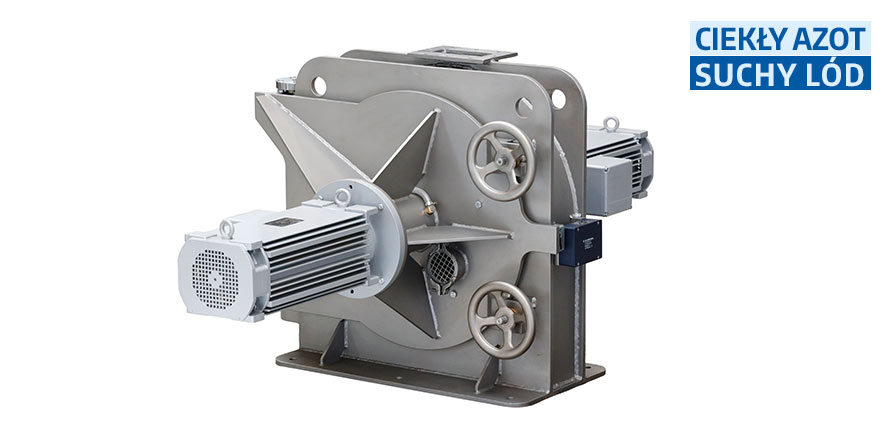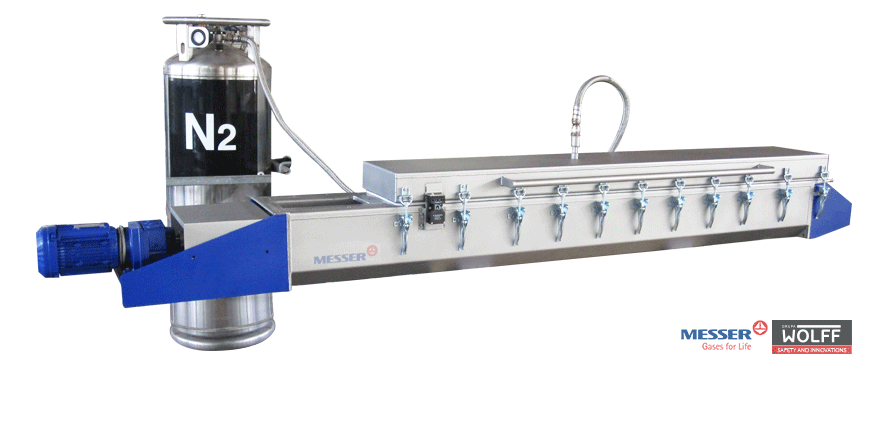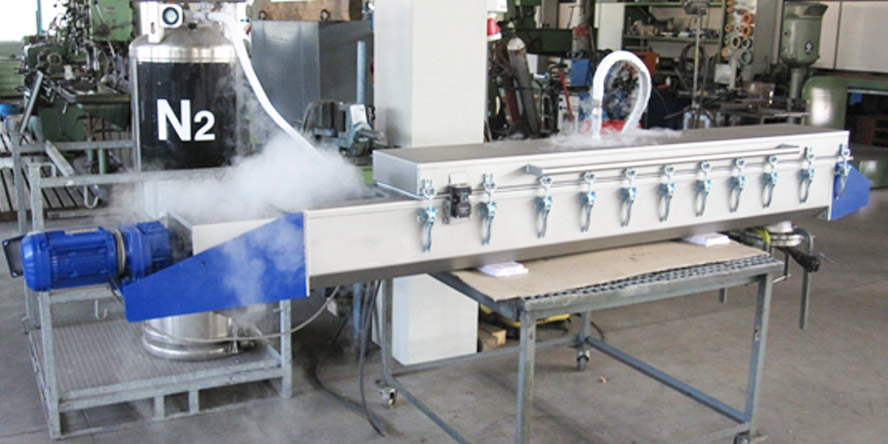Did you know?
- cryogrinding is successfully used for grinding herbs – prevent clumping, clogging. Help keep aroma and aroma oils
- cryogrinding able to grind products with a high content of sugar like chokeberry or beetroot – they don’t stick together due to lack of steam in system
- cryogrinding is completely explosion free – there’s no oxygen in grinding system
- all fibers product are easily grinded
Benefits:
- higher efficiency of the production process
- the possibility of obtaining finer particles of powders
- no thermal damage (e.g. when grinding pharmaceuticals)
- no damage in the form of oxidation (e.g. when grinding nuts)
- no fire hazard or dust explosion
Cryogrinding is used in:
- pharmaceutical industry
- rubber industry
- plastics industry
- food industry
- production of industrial mills
- recycling
Example: Cryogrinding in food industry
Cryogenic grinding is well known for herb and spices companies. Below results from chosen trials:
| Material: | Black Pepper | Cumin Seeds (Kreuzkümmel) | Mustard White Seeds |
|---|---|---|---|
| Bag Label: | Black Pepper | G/011018/107 | G/011018/108 |
| Feeding Size [mm]: | 4 mm, sphere | 5 x 1 mm | 2 mm, sphere |
| Oil content: | ~2% | 15 to 20% | 30 to 40% |
| Bulk Weight [kg/l]: | 0,53 | 0,48 | 0,74 |
| Material Amount [kg]: | 10,0 | 20,00 | 21,10 |
| Target: | 80 to 300 µm | 80 to 300 µm | 80 to 300 µm |
All materials was easily grinded and PSD was exactly as below:
Particle size distribution ground grain:
| Separating Agent [%] | Black Pepper | Cumin Seeds (Kreuzkümmel) | Mustard White Seeds |
|---|---|---|---|
| < 1000 µm [%] | 0 | ||
| < 500 µm [%] | 98,2 | 98,4 | 95,2 |
| < 315 µm [%] | 95,2 | 95,0 | 87,5 |
| < 250 µm [%] | 87,5 | 77,0 | |
| < 100 µm [%] | 49,8 | 87,0 | 12,0 |
| < 63 µm [%] | 19,8 | 1,9 | 2,2 |

As an example for a different problem than herbs we can show studycase:
- production of plastic elements (foamed EVA) generates several hundred tons of problematic waste per year
- studies have shown that the residue can be reused in production in the form of very fine dust (below 300 µm)
- Unfortunately, due to the very high flexibility of the product, fragmentation of waste by traditional methods is practically impossible
Solution:
- most soft, flexible and also hot melt products change their brittleness at reduced temperatures
- tests on a semi-technical scale, using installations for so-called cryogrinding confirmed our assumptions
- based on tests, we selected and delivered an installation that meets the customers assumptions
Check the details about the implemented solution:
Several hundred tons of waste per year
The production of plastic components using injection molding machines generates a large amount of waste. For our client, it was several hundred tons per year. For example, at the time of the implementation of this project, there was a 400-ton left-over heap of waste on the plant premises. Their size ranged from a few millimeters to several centimeters.

Photo 1. Pin mill

Photo 2. Feeder
Assumptions for the cryogrinding process
- Capacity: 300 kg / h (which gives about 15 t / week)
- Bulk density of product at the entrance: 0.2 kg / dm3
- Input product: 8mm (pre-ground)
- Output: less than 300 µm
- Optimization of investments in terms of costs
How to manage plastic waste
The simplest, but not necessarily the most economical solution would be waste treatment by a specialized company. However, if you want to be competitive on the market, you should look for opportunities where others see problems. That’s how our client approached the task.
Another, more effective solution than utilization could be fragmentation of waste into a homogeneous granulate, and then returning it to injection molding machines. However, it turns out that the reuse of this type of material leads to its vulcanization. Its shock absorbing properties are lost, which significantly reduces the quality of the final product.
Why flexible materials have a hard time
Plastic in the form of foamed EVA is a form of foam that is often used as a cushioning material in the soles of sports shoes. If we tried to crush this part of the sole in a blender or meat grinder, we quickly realized how difficult this process is.
It is no different in the case of industrial mills. These types of products are difficult to cut, require a large amount of energy, and after some time clog the device preventing it from working effectively. Grinding a charge to particles of a few millimeters is an extremely difficult challenge, and pulverizing to particles of a micrometer size can practically be forgotten.
Cryogrinding, i.e. grinding at a reduced temperature
Foams or, more generally, flexible, springy materials are not the only products that, for various reasons, cause problems in the case of classic grinding. In the same group, although for different reasons, there are spices or hot melt products such as wax. However, this is a topic for another article.

Photo 3. Conveyor
Due to problems with grinding of these products, the industry has developed a method of grinding at a reduced temperature, feg. cryogrinding. The lowered temperature changes the properties of these products, making them more fragile. And this is the key to success.
The product is cooled before it is fed into the mill. The most commonly used for this purpose is a screw feeder with nozzles, which cools the material with liquid nitrogen.
What milling temperature is optimal?
How low the process temperature should be is determined by decent performance and the level of fineness of the final product. In other words, the lower the temperature, the higher the efficiency and / or the fineness. On the other hand, the lower the temperature, the higher the nitrogen consumption, which means higher costs. That is why finding the optimum is crucial.
The experience of grinding a similar product will certainly be very helpful here. However, this does not guarantee that the installation implemented on this basis will achieve the assumed parameters. A much better method is semi-technical testing, which we use ourselves. The problem here may be the availability of laboratories that are able to perform these types of tests. There are three of them throughout Europe. Our engineers have access to two of them.
We select the process temperature based on the expected grain size after grinding. Simply put, this process may look like this. If we assume that a satisfactory grinding result is a powder containing 40% of the fraction below 710 µm, then the optimal process temperature will be 0 ° C. However, if we expected the powder to contain as much as 70% below 710 µm, the process temperature would have to drop to -20oC.
NOTE: to preserve the confidentiality of the customer’s technical parameters, the data has been changed and is only a value as an example in this article.
| Temperature after grinding [° C] | -20 | -10 | 0 | 10 |
|---|---|---|---|---|
| Nitrogen consumption [kg / kg] | 7 | 6 | 5 | 3 |
| Fraction below 300 µm [%] | 40 | 30 | 20 | 15 |
| Fraction below 500 µm [%] | 45 | 35 | 30 | 25 |
| Fraction below 710 µm [%] | 55 | 50 | 40 | 40 |
In practice, the tests are more complicated because they take into account the intermediate option, in which a higher temperature is selected than it results directly from the first test, and then the oversized part is returned for grinding. Although this approach requires the use of a screening plant, it can be cheaper in the end in economic terms. This will result from lower consumption of liquid nitrogen.
Installation supplied
Delivery was preceded by tests but also conversations with the customer. Along the way, we considered several concepts including the use of a screen that would give off oversize to recycle for grinding. And also the option of raising the hall to create an installation where the product would be transported by gravity. The optimal solution, however, turned out to be installations without a screen and with pneumatic transport and a screw feeder, which was responsible for product cooling.
The most important components of the installation are:
- pin mill
- Nitrogen cooled screw conveyor, cryo-insulated
- Pneumatic granulate transport system
- Liquid nitrogen storage and dosing installation
- Control system




